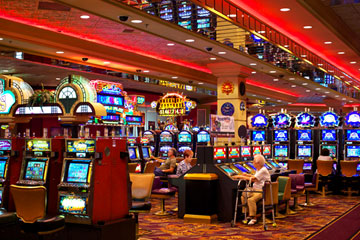
Las Vegas local, Eleanor Kochanski, center right, plays one cent machines in the Penny Lane area of The Orleans casino, in Las Vegas on Wednesday, June 26, 2013.
(5 of 6)
These moves have paid off as the tourists have returned--with one shortfall. "Food and beverage has come back, shows have come back," says Smith, whose company runs off-strip casinos such as Sam's Town and Orleans that are popular with the locals, about 20% of the total Las Vegas market. "Gaming hasn't." The locals are gambling shy too, and who could blame them? They were crushed in the real estate collapse in two ways: most mortgages are still underwater, and 2 out of 3 construction jobs disappeared. Today, locals are just as likely to head to a restaurant as a poker room. That's not as much of a problem for Boyd, whose less-pricey properties, which include everything from bowling alleys to sports bars, aren't as gambling-dependent as destinations on the Strip are. "We don't care where they spend their money," says Smith, "as long as it's with us."
In the higher-end casinos like Caesars, says Loveman, the house used to thrive when highly liquid business types--a car dealer from Southern California, say--spent freely. "That player is still with us," he says. "But one of the unique features of our business is that he can spend considerably less and get the same [thrill]." In 2007 that player might have bet $50 a hand; now he's betting $40 a hand. "We don't know if it's a new normal," Loveman says.
That's not been particularly helpful to Loveman as he tries to maneuver around the company's $21 billion in debt, most of it tied to what turned out to be an incredibly ill-timed leveraged buyout in 2007. Making that debt disappear would be the best magic trick in town. Others have fared far worse. The Riviera went bankrupt (for the third time), as did the LVH, once the Las Vegas Hilton. Projects like the Fontainebleau are frozen on the drawing board. Smith stopped building Boyd's proposed Echelon hotel on the Strip midconstruction in 2008 and recently sold the site to Genting, a Malaysian gambling company, for $350 million. Analysts say the price of real estate on the Las Vegas Strip dropped an astonishing 90% from peak to trough. (Current price: about $4 million per acre.)
Consider the predicament of the Cosmopolitan, a boutique hotel (which in Vegas means 3,000 rooms) loaded with chandeliers, oversize sculptures, giant LED screens, vending machines that sell art and 13 restaurants. The hotel was built for a ridiculous $1.3 million a door. That's 2006 thinking at work, because it implies a $1,300 daily rate at a conventional hotel. With weekday room rates in 2013 under $200, the Cosmopolitan can't possibly earn that investment back on hotel revenue, nor did it plan to. But the young, rich crowd it attracts seems way more interested in its Marquee club than its casino. The hip hotel lost $125 million in its latest two quarters.
Of course, Las Vegas has a knack of figuring its way out of trouble. When its family-friendly strategy faltered in the 1990s, the city transitioned nicely to naughty. Today, the once decrepit downtown district along Fremont Street is being reborn as a cozier place where the scale is smaller and the vibe hipper. It presages a city that's less tourism-dependent, if only it can attract industries beyond tourism.
